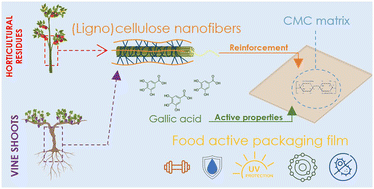Boosting functional properties of active-CMC films reinforced with agricultural residues-derived cellulose nanofibres†
Abstract
The search for packaging alternatives that reduce the presence of non-biodegradable plastics in water is a focus of much research today. This fact, together with the increasing demand for active packaging capable of prolonging the shelf life of foodstuffs and the rise in the use of natural biopolymers such as cellulose, motivate the present work. This work evaluates CMC films loaded with gallic acid reinforced with (ligno)cellulose nanofibres from various agricultural residues as candidates for use in active food packaging. The first stage of the study involved the evaluation of different nanofibres as the reinforcing agent in CMC films. Increasing proportions of nanofibres (1, 3, 5 and 10% w/w) from horticultural residues (H) and nanofibres from vine shoots (V), containing residual lignin (LCNF) and without it (CNF), and obtained by mechanical (M) or chemical (T) pretreatment, were studied. The results of this first stage showed that the optimum reinforcement effect was obtained with 3% H-MCNF or 3% V-MCNF, where up to 391% and 286% improvement in tensile strength was achieved, respectively. These films offered slightly improved UV-light blocking ability (40–55% UV-barrier) and water vapor permeability (20–30% improvement) over CMC. Next, bioactive films were prepared by incorporating 5 and 10% wt of gallic acid (GA) over the optimised formulations. It was found that the joint addition of cellulose nanofibres and GA enhanced all functional properties of the films. Mechanical properties improved to 70%, WVP to 50% and UV light blocking ability to 70% due to the synergistic effect of nanofibres and GA. Finally, the bioactive films exhibited potent antioxidant activity, 60–70% in the DPPH assay and >99% in the ABTS assay and high antimicrobial capacity against S. aureus.

- This article is part of the themed collection: Chemistry in Biorefineries


 Please wait while we load your content...
Please wait while we load your content...